Eonatator is an extinct genus of marine lizard belonging to the mosasaur family. It is a close relative of Halisaurus, and part of the same subfamily, the Halisaurinae. It is known from the Late Cretaceous of North America, Colombia and Sweden. Originally, this taxon was included within Halisaurus, but was placed in its own genus, which also led to the subfamily Halisaurinae being created for the two genera.
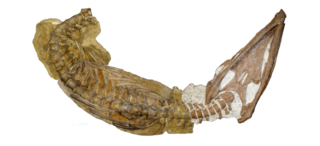
Brachauchenius is an extinct genus of pliosaurid that lived in North America and Morocco during the Late Cretaceous.

Yaguarasaurus is an extinct genus of mosasauroid from the Late Cretaceous (Turonian) period of Colombia, South America. The remains discovered were defined as a new genus and species of mosasaurid, Yaguarasaurus columbianus, by the Colombian paleontologist María Páramo, former director of the Museo de Geología José Royo y Gómez of INGEOMINAS in Bogotá. The first fossils remains of this animal suggested a cranial length of 47 centimetres (19 in) and a total length of 5 metres (16 ft); an additional skull that measures 87 centimetres (34 in) long implies a larger size.

The Paja Formation is an Early Cretaceous geologic formation of central Colombia. The formation extends across the northern part of the Altiplano Cundiboyacense, the Western Colombian emerald belt and surrounding areas of the Eastern Ranges of the Colombian Andes. In the subsurface, the formation is found in the Middle Magdalena Valley to the west. The Paja Formation stretches across four departments, from north to south the southernmost Bolívar Department, in Santander, Boyacá and the northern part of Cundinamarca. Well known fossiliferous outcrops of the formation occur near Villa de Leyva, also written as Villa de Leiva, and neighboring Sáchica.

Phosphorosaurus is an extinct genus of marine lizard belonging to the mosasaur family. Phosphorosaurus is classified within the Halisaurinae subfamily alongside the genera Pluridens, Eonatator, and Halisaurus.

Padillasaurus is an extinct genus of titanosauriform sauropod known from the Early Cretaceous Paja Formation in Colombia. It contains a single species, Padillasaurus leivaensis, known only from a single partial axial skeleton. Initially described as a brachiosaurid, it was considered to be the first South American brachiosaurid ever discovered and named. Before its discovery, the only known brachiosaurid material on the continent was very fragmentary and from the Jurassic period. However, a more recent study finds it to be a basal somphospondylan.
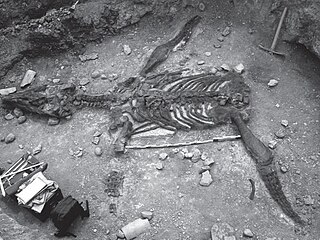
Stenorhynchosaurus is an extinct genus of pliosaurid plesiosaurs which lived in the Early Cretaceous of South America. The type species and only known is Stenorhynchosaurus munozi.
Zapata Formation is a sedimentary formation of Lower Cretaceous age in the Magallanes or Austral Basin of Argentina and Chile. Much of the formation is folded and faulted as consequence of the Andean orogeny. In outcrops of the Zapata Formation near Torres del Paine, the ichthyosaur genus Myobradypterygius has been found.
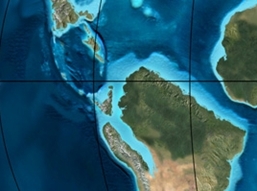
The La Frontera Formation (Spanish: Formación La Frontera, K2F, Ksf) is a geological formation, part of the Villeta Group, of the Altiplano Cundiboyacense and neighbouring areas of the Eastern Ranges of the Colombian Andes. The sequence of limestones and lydites dates to the Late Cretaceous period; Turonian epoch and has a maximum thickness of 206 metres (676 ft).
Fernando Etayo Serna is a Colombian paleontologist and geologist. His contributions on the paleontology in Colombia has been mainly on the descriptions of ammonites and Etayo has helped describing many fossiliferous geologic formations of Colombia. Etayo obtained his MSc. degree in geology and geophysics from the Universidad Nacional de Colombia in 1963, and his PhD in paleontology from the University of California, Berkeley in 1975.

Leyvachelys is an extinct genus of turtles in the family Sandownidae from the Early Cretaceous of the present-day Altiplano Cundiboyacense, Eastern Ranges, Colombian Andes. The genus is known only from its type species, Leyvachelys cipadi, described in 2015 by Colombian paleontologist Edwin Cadena. Fossils of Leyvachelys have been found in the fossiliferous Paja Formation, close to Villa de Leyva, Boyacá, after which the genus is named. The holotype specimen is the oldest and most complete sandownid turtle found to date.
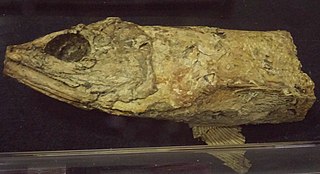
Goulmimichthys is an extinct genus of ray-finned fishes in the family Pachyrhizodontidae. The genus, first described by Cavin in 1995, is known from various Turonian age formations. The type species G. arambourgi from the Akrabou Formation in the El Rachidia Province of Morocco, and other fossils described are G. gasparini of the La Frontera Formation, Colombia, and G. roberti from the Agua Nueva Formation of Mexico.

The Hondita Formation is a fossiliferous geological formation of the Upper Magdalena Valley (VSM) and surrounding Central and Eastern Ranges of the Colombian Andes, extending from Cundinamarca in the north to Huila and easternmost Tolima in the south. The lowermost unit of the Güagüaquí Group, a sequence of sandy limestones and shales, dates to the Late Cretaceous period; Turonian epoch, and has a maximum thickness of 90 metres (300 ft).

The Oliní Group (Spanish: Grupo Oliní, K3k5o, K2ol, Kso) is a fossiliferous geological group of the VMM, VSM and the eastern flanks of the Central and western flanks of the Eastern Ranges of the Colombian Andes. The regional group stretches from north to south across approximately 700 kilometres (430 mi) and dates to the Late Cretaceous period; Coniacian, Santonian and Campanian epochs, and has a maximum thickness of 287 metres (942 ft). Fossils of Eonatator coellensis have been found in the unit, near Coello, Tolima.
Leivanectes is a genus of plesiosaurs of the family Elasmosauridae known from Late Aptian marine deposits in central Colombia. It contains a single species, L. bernadoi, which was described in 2019.

Sachicasaurus is an extinct genus of brachauchenine pliosaurid known from the Barremian of the Paja Formation, Altiplano Cundiboyacense in the Colombian Eastern Ranges of the Andes. The type species is S. vitae.
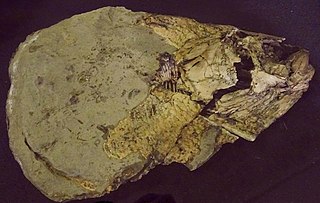
Bachea is an extinct genus of ray-finned fish that lived during the Late Cretaceous in what is now central Colombia, South America. The type species is Bachea huilensis, described in 1997 by María Páramo from the Turonian of Huila, Colombia.

Kyhytysuka is an extinct genus of ophthalmosaurian ichthyosaur from Early Cretaceous Colombia. The animal was previously assigned to the genus Platypterygius, but given its own genus in 2021. Kyhytysuka was a mid-sized ophthalmosaurian with heterodont dentition and several adaptations suggesting that it was a macropredatory vertebrate hunter living in shallow waters. It contains a single species, Kyhytysuka sachicarum.
















